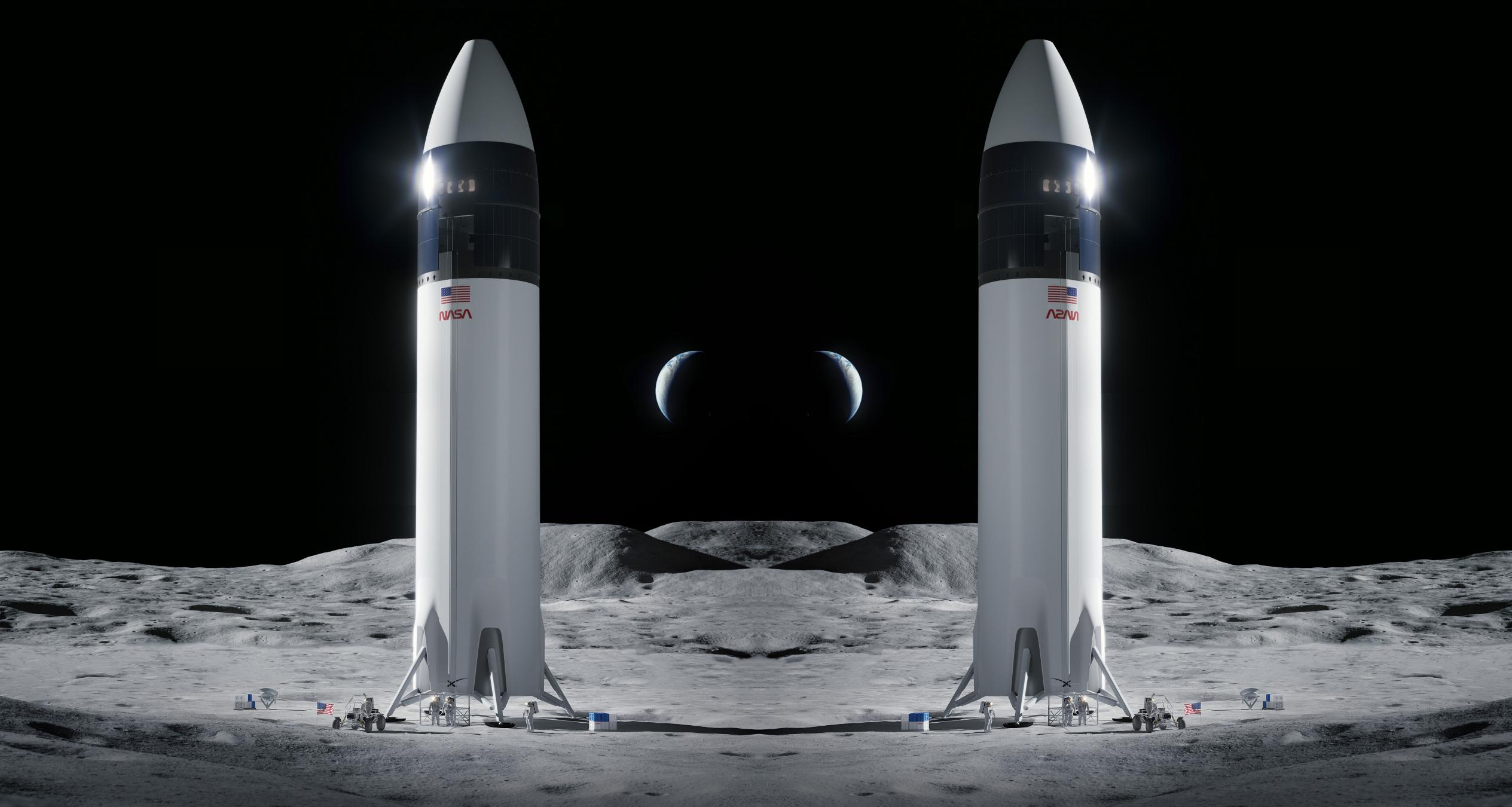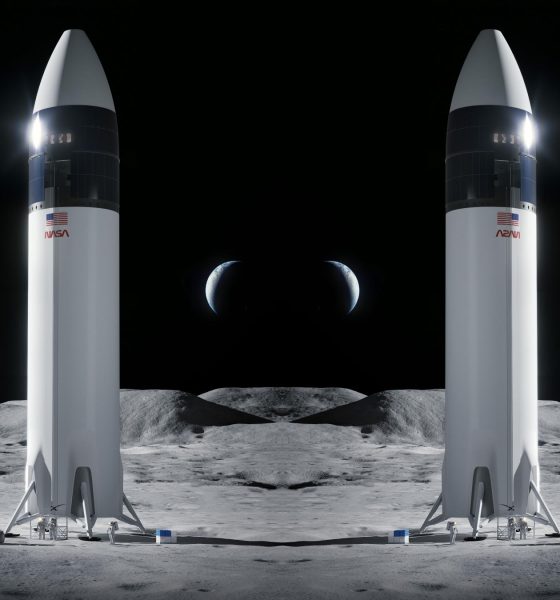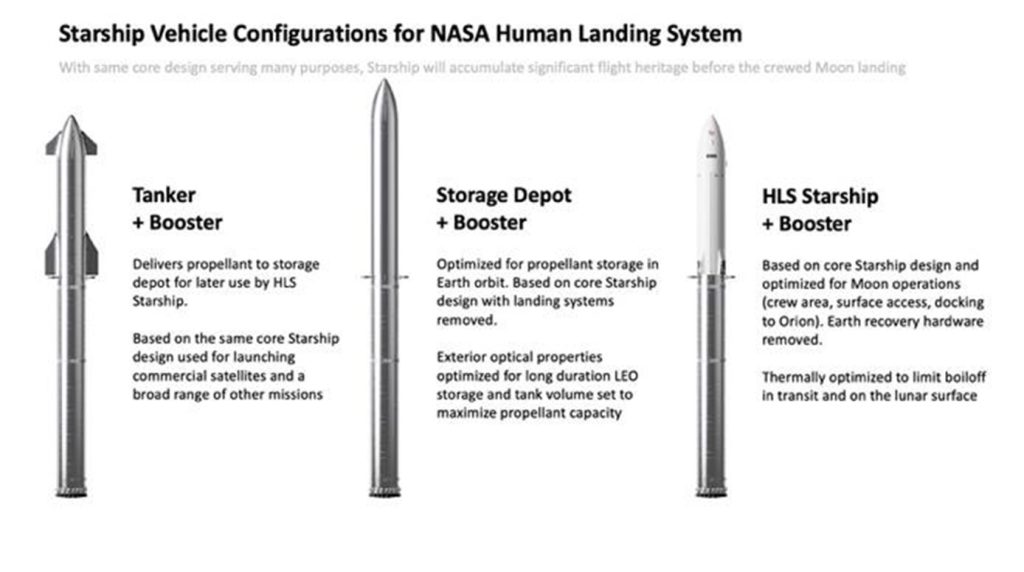

News
SpaceX, NASA finalize contract for second crewed Starship Moon landing
Around eight months after announcing its intention to do so, NASA has awarded SpaceX a contract for a second crewed Starship Moon landing as early as 2027.
Known as Option B, NASA has exercised a baked-in right to modify its Human Landing System (HLS) Option A contract with SpaceX – signed in April 2021 – to extract even more value from investments into the program. In addition to an uncrewed Starship Moon landing planned no earlier than (NET) 2024 and a crewed demonstration that could land two NASA astronauts on the Moon as early as 2025, NASA’s contract modification gives SpaceX the approval and resources it needs to prepare for a second crewed Starship Moon landing.
On top of securing NASA’s Artemis IV mission astronauts a ride to the lunar surface, the Option B contract will also allow SpaceX and NASA to pursue and demonstrate upgrades that will make Starship an even more capable and cost-effective Moon lander.
Update: NASA says that the Option B modification will cost $1.15 billion, raising the maximum value of SpaceX’s HLS contract to approximately $4.2 billion.
When NASA first announced its intention to add a second crewed Moon landing to SpaceX’s existing HLS contract, the agency couldn’t offer specific information about when that landing might occur or which Artemis mission it would be attached to. Part of the reason for that uncertainty was another announcement two months prior that NASA no longer expected a Moon landing to be paired with its Artemis IV (4) mission. And five days after a March 2022 announcement of plans for a second crewed Starship Moon landing, NASA seemingly reaffirmed that there would be a multi-year gap between Starship’s first crewed Moon landing (NET 2025; tied to Artemis III) and NASA’s second crewed Moon landing, which would use an unspecified lander.
But as of November 2022, NASA has thankfully abandoned plans to intentionally allow a gap between Moon landings. SpaceX’s Starship is now on contract to support back-to-back crewed Moon landings NET 2025 and 2027 as part of NASA’s Artemis III and Artemis IV missions. It’s unclear how or why NASA was able to make that change, but it’s a definite improvement over the alternative.

Additionally, NASA will work with SpaceX to debut new capabilities and improvements on Starship’s second crewed Moon landing. While the Artemis III landing will be about as barebones as possible, the Artemis IV Starship will be upgraded with the ability to transport more NASA astronauts (four instead of just two) and more cargo to the lunar surface. It’s not entirely clear, but NASA reportedly wants to land just ~180 kilograms (~400 lb) of cargo with the first crewed Starship, a vehicle likely capable of landing dozens of tons of cargo in addition to several astronauts. NASA hopes that future “sustainable” lander missions, a category that Starship’s Option B landing may or may not fall under, will transport up to one ton (~2200 lb) of cargo to and from the lunar surface.
Finally, the Artemis IV Starship will also be able to dock with NASA’s Lunar Gateway. Gateway is a small deep space station that will be located in a strange, high lunar orbit. It exists almost exclusively to give NASA’s Space Launch System (SLS) rocket and Orion crew capsule a destination they can both reach. The Orion capsule is almost twice as heavy as its Apollo counterpart and its European Service Module (ESM) offers less than half the performance of NASA’s retired Apollo Service Module. Combined, Orion is physically incapable of transporting itself (or astronauts) to the simpler low lunar orbits used by the Apollo Program.
Instead, NASA’s new Moon lander(s) have to pick up Orion’s slack. Starship will be responsible for picking up astronauts in a lunar near-rectilinear halo orbit (NRHO), transporting them to low lunar orbit, and returning them to NRHO in addition to landing on the Moon, spending a week on the surface, and launching back into lunar orbit.
Until it’s modestly upgraded in the late 2020s or 2030s, Gateway will be equally underwhelming. In fact, that’s part of the reason that Starship docking with the Gateway is in any way significant. SpaceX and NASA have decades of expertise docking and berthing spacecraft with space stations. But those spacecraft are typically smaller and lighter than the stations they were joining. Even after the Gateway is fully outfitted with a range of international modules, Starship will likely weigh several times more than the tiny station, making docking even more challenging than it already is.
Starship’s Moon lander variant could also have a cabin with hundreds of cubic meters of habitable space, while the Gateway is unlikely to ever have more than a few dozen. Having a Starship docked would thus immediately make the ultra-cramped station far more livable.
NASA says Artemis IV and the second crew Starship Moon landing will occur as early as 2027. But a ‘space prophet’ who predicted in 2017 that NASA’s SLS launch debut would slip from 2019 to “around 2023” and forecasted that SpaceX alone would win NASA’s Moon lander contract recently told Ars Technica’s Eric Berger that Artemis III, the mission before Artemis IV, is unlikely to launch before 2028. At the time, that source’s predictions verged on blasphemy, but they’ve ultimately proven to be eerily accurate. Only time will tell if their third ‘prophecy’ follows the same path.

News
Tesla is not sparing any expense in ensuring the Cybercab is safe
Images shared by the longtime watcher showed 16 Cybercab prototypes parked near Giga Texas’ dedicated crash test facility.

The Tesla Cybercab could very well be the safest taxi on the road when it is released and deployed for public use. This was, at least, hinted at by the intensive safety tests that Tesla seems to be putting the autonomous two-seater through at its Giga Texas crash test facility.
Intensive crash tests
As per recent images from longtime Giga Texas watcher and drone operator Joe Tegtmeyer, Tesla seems to be very busy crash testing Cybercab units. Images shared by the longtime watcher showed 16 Cybercab prototypes parked near Giga Texas’ dedicated crash test facility just before the holidays.
Tegtmeyer’s aerial photos showed the prototypes clustered outside the factory’s testing building. Some uncovered Cybercabs showed notable damage and one even had its airbags engaged. With Cybercab production expected to start in about 130 days, it appears that Tesla is very busy ensuring that its autonomous two-seater ends up becoming the safest taxi on public roads.
Prioritizing safety
With no human driver controls, the Cybercab demands exceptional active and passive safety systems to protect occupants in any scenario. Considering Tesla’s reputation, it is then understandable that the company seems to be sparing no expense in ensuring that the Cybercab is as safe as possible.
Tesla’s focus on safety was recently highlighted when the Cybertruck achieved a Top Safety Pick+ rating from the Insurance Institute for Highway Safety (IIHS). This was a notable victory for the Cybertruck as critics have long claimed that the vehicle will be one of, if not the, most unsafe truck on the road due to its appearance. The vehicle’s Top Safety Pick+ rating, if any, simply proved that Tesla never neglects to make its cars as safe as possible, and that definitely includes the Cybercab.
Elon Musk
Tesla’s Elon Musk gives timeframe for FSD’s release in UAE
Provided that Musk’s timeframe proves accurate, FSD would be able to start saturating the Middle East, starting with the UAE, next year.

Tesla CEO Elon Musk stated on Monday that Full Self-Driving (Supervised) could launch in the United Arab Emirates (UAE) as soon as January 2026.
Provided that Musk’s timeframe proves accurate, FSD would be able to start saturating the Middle East, starting with the UAE, next year.
Musk’s estimate
In a post on X, UAE-based political analyst Ahmed Sharif Al Amiri asked Musk when FSD would arrive in the country, quoting an earlier post where the CEO encouraged users to try out FSD for themselves. Musk responded directly to the analyst’s inquiry.
“Hopefully, next month,” Musk wrote. The exchange attracted a lot of attention, with numerous X users sharing their excitement at the idea of FSD being brought to a new country. FSD (Supervised), after all, would likely allow hands-off highway driving, urban navigation, and parking under driver oversight in traffic-heavy cities such as Dubai and Abu Dhabi.
Musk’s comments about FSD’s arrival in the UAE were posted following his visit to the Middle Eastern country. Over the weekend, images were shared online of Musk meeting with UAE Defense Minister, Deputy Prime Minister, and Dubai Crown Prince HH Sheikh Hamdan bin Mohammed. Musk also posted a supportive message about the country, posting “UAE rocks!” on X.
FSD recognition
FSD has been getting quite a lot of support from foreign media outlets. FSD (Supervised) earned high marks from Germany’s largest car magazine, Auto Bild, during a test in Berlin’s challenging urban environment. The demonstration highlighted the system’s ability to handle dense traffic, construction sites, pedestrian crossings, and narrow streets with smooth, confident decision-making.
Journalist Robin Hornig was particularly struck by FSD’s superior perception and tireless attention, stating: “Tesla FSD Supervised sees more than I do. It doesn’t get distracted and never gets tired. I like to think I’m a good driver, but I can’t match this system’s all-around vision. It’s at its best when both work together: my experience and the Tesla’s constant attention.” Only one intervention was needed when the system misread a route, showcasing its maturity while relying on vision-only sensors and over-the-air learning.
News
Tesla quietly flexes FSD’s reliability amid Waymo blackout in San Francisco
“Tesla Robotaxis were unaffected by the SF power outage,” Musk wrote in his post.

Tesla highlighted its Full Self-Driving (Supervised) system’s robustness this week by sharing dashcam footage of a vehicle in FSD navigating pitch-black San Francisco streets during the city’s widespread power outage.
While Waymo’s robotaxis stalled and caused traffic jams, Tesla’s vision-only approach kept operating seamlessly without remote intervention. Elon Musk amplified the clip, highlighting the contrast between the two systems.
Tesla FSD handles total darkness
The @Tesla_AI account posted a video from a Model Y operating on FSD during San Francisco’s blackout. As could be seen in the video, streetlights, traffic signals, and surrounding illumination were completely out, but the vehicle drove confidently and cautiously, just like a proficient human driver.
Musk reposted the clip, adding context to reports of Waymo vehicles struggling in the same conditions. “Tesla Robotaxis were unaffected by the SF power outage,” Musk wrote in his post.
Musk and the Tesla AI team’s posts highlight the idea that FSD operates a lot like any experienced human driver. Since the system does not rely on a variety of sensors and a complicated symphony of factors, vehicles could technically navigate challenging circumstances as they emerge. This definitely seemed to be the case in San Francisco.
Waymo’s blackout struggles
Waymo faced scrutiny after multiple self-driving Jaguar I-PACE taxis stopped functioning during the blackout, blocking lanes, causing traffic jams, and requiring manual retrieval. Videos shared during the power outage showed fleets of Waymo vehicles just stopping in the middle of the road, seemingly confused about what to do when the lights go out.
In a comment, Waymo stated that its vehicles treat nonfunctional signals as four-way stops, but “the sheer scale of the outage led to instances where vehicles remained stationary longer than usual to confirm the state of the affected intersections. This contributed to traffic friction during the height of the congestion.”
A company spokesperson also shared some thoughts about the incidents. “Yesterday’s power outage was a widespread event that caused gridlock across San Francisco, with non-functioning traffic signals and transit disruptions. While the failure of the utility infrastructure was significant, we are committed to ensuring our technology adjusts to traffic flow during such events,” the Waymo spokesperson stated, adding that it is “focused on rapidly integrating the lessons learned from this event, and are committed to earning and maintaining the trust of the communities we serve every day.”








